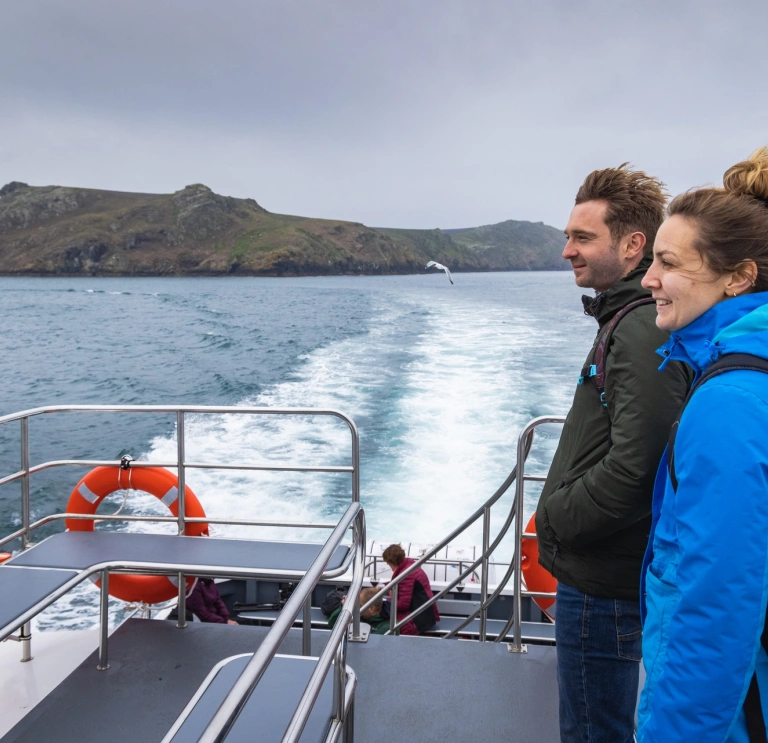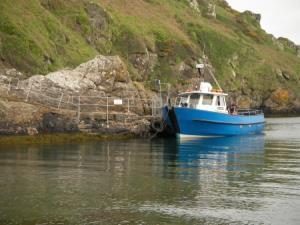A haven for wildlife less than a mile off the Pembrokeshire coast, Skomer Island is a privilege to visit. Home to puffins, Manx shearwaters, dolphins, seals, razorbills and many more types of wildlife, it's loved by nature enthusiasts and photographers.
Why Skomer Island is worth a visit
One of the things that makes Skomer so special is its abundance of wildlife all year round. Depending on when you visit, you'll get to see different uncommon and rare animals in their natural habitat. At any time of year, you might see grey seals in the water (their cute pups tend to emerge between August and November), porpoises or acrobatic choughs taking flight.
It's one of Britain's best sites for seabird colonies; Skomer has the largest breeding colony of Manx shearwaters in the world - some 350,000 breeding pairs - who return every March until September. There are also northern ravens, razorbills, guillemots, storm petrels and kittiwakes, to name but a few of the other feathered friends who call Skomer home.



The Skomer Island puffins are perhaps its most famous inhabitants, who stay on the island from March to August. Adult puffins make nests and lay their eggs until mid May, when the chicks start hatching. From then, it's a feeding frenzy; adult puffins fish for food in the waters and bring it to their young, while the little ones practice daily life in their growing bodies. The chicks fledge in July and August, with the adults leaving shortly afterwards.

If you visit in May and June, it's likely you'll see carpets of bluebells and red campion flowers across the island. Later in the year, thrift and sea campion are dotted along the cliff edges. As an exposed island with rocky outcrops, there's an abundance of marshland, bracken and grassland all year round.
During the open season, the Wildlife Trust of South & West Wales hold events on Skomer, including guided tours, yoga retreats and overnight wildlife experiences.
To protect the island's natural integrity, ecosystems and inhabitants, the number of visitors allowed on the island per day is capped at 250.
Read more: Meet the puffins and other birds on Skomer Island


How much does it cost to go to Skomer Island?
A visit to Skomer Island makes for an unforgettable day out. Only one tour operator runs Skomer Island Landing Trips. Board the boat at Lockley Lodge, Martin's Haven, for a 15-minute ride to Skomer Island. You'll be dropped off to enjoy the island at your own pace, then picked up for the return sailing 4.5 hours later. Tickets cost £24-£44 depending on the traveller's age and the time of year. Book your tickets in advance as space is limited, and check for weather updates nearer the time.
You can also take wildlife watching boat trips around Skomer.

How long is the ferry to Skomer Island?
The journey to Skomer Island takes 15 minutes each way. Landings operate from Tuesday to Sunday between April and September. You'll be allocated a return boat when you check in. Departures are every half hour between 10am and 12pm, with return sailings allocated in half-hour intervals between 3pm to 5pm.


Is there accommodation on Skomer Island?
There is a limited amount of accommodation on Skomer Island, which is provided by the Welsh Wildlife Trust. The Skomer Island accommodation consists of a converted farmhouse hostel in the middle of the island. It sleeps up to 16 people in single beds and bunks, with the option to reserve a bunk or a private room. There are basic kitchen, dining, living and bathroom facilities.
But the best part? Once the last boat of the day sails from the island, you get Skomer to yourself! Watch the sunset, see birds coming home for the night or chat to the Skomer Team about your sightings. Book your Skomer Island accommodation well ahead to ensure your space.
Accessibility on Skomer Island
As a remote island, accessibility and visitor facilities are limited on Skomer Island. Make sure to bear this in mind ahead of travelling. There are four compost toilets at the centre of the island at the Farm, but no food or drink facilities except for bottled water for sale.
Please note that:
- There are 87 steep steps to climb to access the island
- The paths are uneven, rocky and hilly
- There are limited toilet facilities and no café facilities (water is available to buy)
- No dogs are permitted
- The island is exposed with very little shelter or shade
- There are no bins (take all rubbish home, including organic matter)
- Binoculars can be hired for £5 on the island










